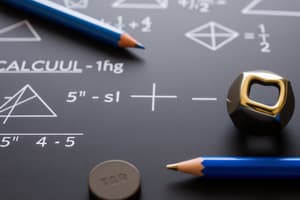Podcast
Questions and Answers
Which property of addition states that changing the order of the addends does not change the sum?
Which property of addition states that changing the order of the addends does not change the sum?
- Associative Property
- Distributive Property
- Identity Property
- Commutative Property (correct)
In the context of functions, what does the term 'input-output relationships' refer to?
In the context of functions, what does the term 'input-output relationships' refer to?
- The sequence of numbers generated by algorithms
- The effect of changing inputs on resulting outputs (correct)
- The values of constant terms only
- The correlation between variables in an equation
Which theorem is used to relate the lengths of the sides of a right triangle?
Which theorem is used to relate the lengths of the sides of a right triangle?
- Pythagorean Theorem (correct)
- Thales' Theorem
- Congruence Theorem
- Triangle Inequality Theorem
What is the primary focus of calculus when analyzing functions?
What is the primary focus of calculus when analyzing functions?
In statistics, what are the three measures of central tendency commonly used?
In statistics, what are the three measures of central tendency commonly used?
Flashcards are hidden until you start studying
Study Notes
Key Areas in Mathematics
-
Arithmetic
- Basic operations: Addition, Subtraction, Multiplication, Division.
- Properties: Commutative, Associative, Distributive.
- Order of operations (PEMDAS/BODMAS).
-
Algebra
- Variables and constants: Use of letters to represent numbers.
- Expressions and equations: Forming and solving.
- Functions: Understanding input-output relationships.
-
Geometry
- Basic shapes: Triangles, Circles, Quadrilaterals.
- Properties: Area, Perimeter, Volume, Surface Area.
- Theorems: Pythagorean theorem, properties of angles.
-
Trigonometry
- Functions: Sine, Cosine, Tangent and their reciprocals.
- Relationships: SOH-CAH-TOA for right triangles.
- Unit circle and radian measure.
-
Calculus
- Limits: Understanding behavior of functions at boundaries.
- Derivatives: Rate of change, slopes of curves.
- Integrals: Area under curves, accumulation of quantities.
-
Statistics
- Types of data: Qualitative vs Quantitative.
- Measures of central tendency: Mean, Median, Mode.
- Probability: Basic concepts and rules.
-
Number Theory
- Prime numbers: Definition and properties.
- Factors and multiples: GCD, LCM.
- Divisibility rules.
-
Linear Algebra
- Vectors and matrices: Operations and properties.
- Systems of equations: Solving using substitution, elimination, or matrix methods.
- Eigenvalues and eigenvectors.
-
Discrete Mathematics
- Combinatorics: Counting principles, permutations, and combinations.
- Graph theory: Vertices, edges, paths, and cycles.
- Logic: Propositions, truth tables, and logical operations.
Study Tips
- Practice regularly: Solve a variety of problems to build skills.
- Understand concepts: Aim for comprehension rather than memorization.
- Utilize resources: Use textbooks, online platforms, and tutoring if needed.
- Work in groups: Collaborate to solve problems and explain concepts.
Arithmetic
- Fundamental operations: Addition, Subtraction, Multiplication, and Division build the foundation for all mathematical calculations.
- Essential properties: Commutative (order doesn't matter), Associative (grouping doesn't matter), and Distributive (multiplying a sum by a number) govern how operations interact.
- Order of operations: The acronym PEMDAS (Parentheses, Exponents, Multiplication & Division, Addition & Subtraction) or BODMAS (Brackets, Orders, Division & Multiplication, Addition & Subtraction) ensures calculations are performed in the correct sequence.
Algebra
- Represents numbers using letters, allowing for generalization and solving equations.
- Expressions are combinations of variables, constants, and operations, while equations set expressions equal to each other.
- Functions model relationships between inputs and outputs, helping to predict and understand how one quantity changes based on another.
Geometry
- Explores the properties of shapes, including triangles, circles, and quadrilaterals.
- Key concepts include area, perimeter, volume (for three-dimensional shapes), and surface area.
- Theorems like the Pythagorean theorem (relating the sides of a right triangle) and angle properties provide specific rules and relationships.
Trigonometry
- Deals with the relationships between angles and sides in triangles.
- Utilizes trigonometric functions like sine, cosine, and tangent (and their reciprocals like cosecant, secant, and cotangent).
- The mnemonic SOH-CAH-TOA (Sine = Opposite/Hypotenuse, Cosine = Adjacent/Hypotenuse, Tangent = Opposite/Adjacent) helps remember trigonometric function relationships in right triangles.
- The Unit Circle is a key tool for understanding angles and trigonometric values in radians.
Calculus
- Focuses on the study of change and its relationship to functions.
- Limits help understand the behavior of functions as input values approach specific points.
- Derivatives measure rates of change and provide information about the slopes of curves.
- Integrals calculate areas under curves and represent the accumulation of quantities.
Statistics
- Analyzes data to gain insights and draw conclusions.
- Differentiates between qualitative data (descriptive) and quantitative data (numerical).
- Measures of central tendency like mean, median, and mode represent average or typical values within a dataset.
- Probability deals with the likelihood of events occurring.
Number Theory
- Investigates the properties of whole numbers.
- Prime numbers are divisible only by 1 and themselves, forming the building blocks of other integers.
- Factors and multiples explore divisibility relationships: GCD (greatest common divisor) and LCM (least common multiple) are key concepts.
- Divisibility rules help simplify finding factors and multiples of specific numbers.
Linear Algebra
- Deals with vectors and matrices, which have applications in various fields like physics and computer science.
- Manipulates vectors and matrices through operations like addition, subtraction, multiplication, and scalar multiplication.
- Solves systems of linear equations using methods like substitution, elimination, or matrix-based techniques.
- Eigenvalues and eigenvectors represent special properties of linear transformations.
Discrete Mathematics
- Focuses on objects and structures that are typically finite and distinct, as opposed to continuous.
- Combinatorics deals with counting arrangements and combinations of elements.
- Graph theory involves networks represented by vertices and edges, studying paths and cycles.
- Logic analyzes logical statements, truth tables, and operations like conjunction, disjunction, and negation.
Studying That Suits You
Use AI to generate personalized quizzes and flashcards to suit your learning preferences.




